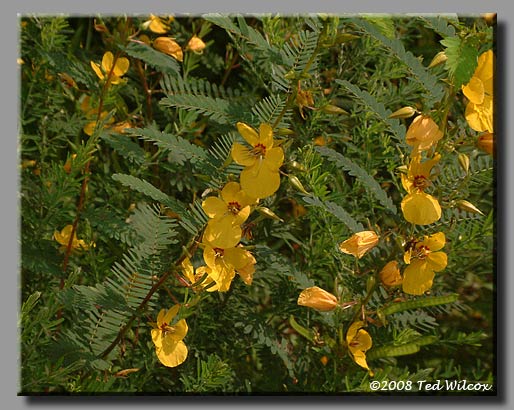
The specific name butterfly pea is given to this vine due to its beautiful blue or purple flowers, which resembles a small butterfly. It is a flowering vine native to tropical Asian and African countries.

Partridge pea is considered an important honey plant, often occurring where few other honey plants are found. Partridge pea often grows in dense stands, producing litter and plant stalks that furnish cover for upland game birds, small mammals, small non-game birds, and waterfowl. Seeds of this legume are also eaten by the greater and lesser prairie-chicken, ring-necked pheasant, mallard grassland birds. Partridge pea seeds are high in phosphorus content and protein value, and low in crude fiber and lignin making digestibility generally high. Partridge pea was found to be one of the most important fall and winter foods of bobwhite quail in Alabama. seed is one of the major food items of northern bobwhite and other quail species because it remains in sound condition throughout the winter and early spring. (I think I've watered them by hose a few times so far this year.) As you can see, they appear to be thriving.
PARTRIDGE PEA SEEDLING FULL
These plants are growing in full sun on unamended, compacted clay soil with very little supplemental irrigation. The only place I've seen it growing wild (and it might actually have been planted there) was alongside a parking lot in a South Florida nature preserve. Partridge pea is native to Tennessee and throughout much of the rest of the Central and Eastern U.S. Some seedlings have sprouted in the lawn too, but they don't seem to flower (so far) with regular mowing and are easy to pull, so I'm not too worried about this plant becoming a lawn weed. I harvested some of the seeds to scatter around the garden and let other seeds fall naturally to the ground beneath the plant. Last spring, I only had a few plants germinate, but this year I have dozens of plants. I scattered ~ 130 seeds outdoors in autumn 2015 from Kansas Native Plants. When the pods ripen, they turn a dark reddish color and split open to release their seeds, some of which will ideally sprout to create next year's partridge peas.

Pollination results in the formation of these long seedpods. presumably to harvest the pollen? It's fun to observe! The bumblebees fly up into the partridge pea ( Chamaecrista fasciculata) flowers and then vibrate with a high-pitched buzz.


 0 kommentar(er)
0 kommentar(er)
